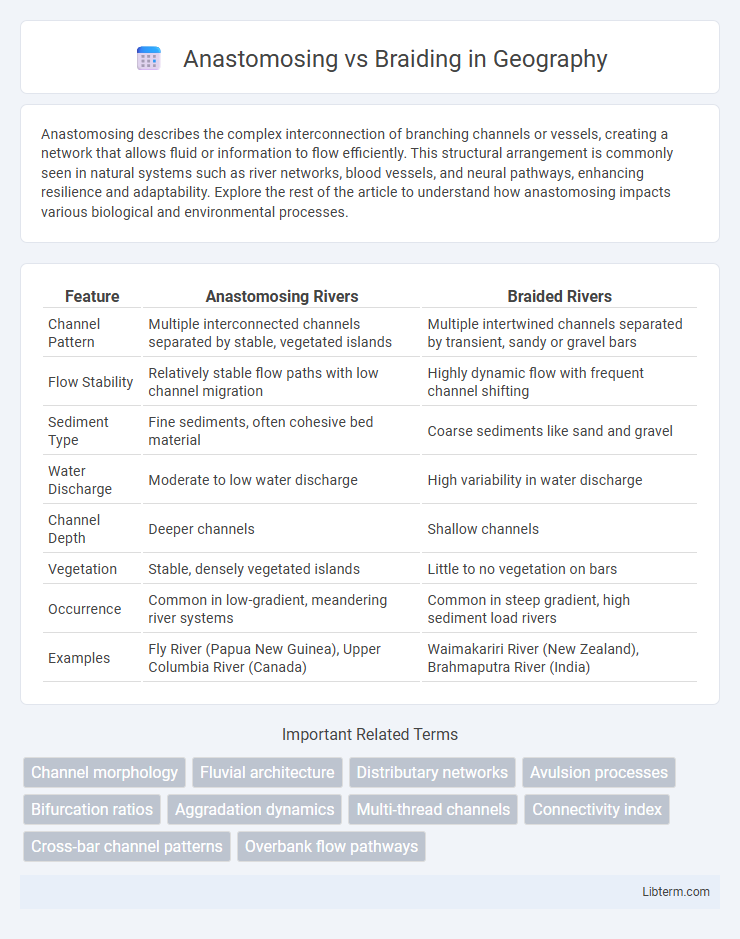Anastomosing describes the complex interconnection of branching channels or vessels, creating a network that allows fluid or information to flow efficiently. This structural arrangement is commonly seen in natural systems such as river networks, blood vessels, and neural pathways, enhancing resilience and adaptability. Explore the rest of the article to understand how anastomosing impacts various biological and environmental processes.
Table of Comparison
| Feature | Anastomosing Rivers | Braided Rivers |
|---|---|---|
| Channel Pattern | Multiple interconnected channels separated by stable, vegetated islands | Multiple intertwined channels separated by transient, sandy or gravel bars |
| Flow Stability | Relatively stable flow paths with low channel migration | Highly dynamic flow with frequent channel shifting |
| Sediment Type | Fine sediments, often cohesive bed material | Coarse sediments like sand and gravel |
| Water Discharge | Moderate to low water discharge | High variability in water discharge |
| Channel Depth | Deeper channels | Shallow channels |
| Vegetation | Stable, densely vegetated islands | Little to no vegetation on bars |
| Occurrence | Common in low-gradient, meandering river systems | Common in steep gradient, high sediment load rivers |
| Examples | Fly River (Papua New Guinea), Upper Columbia River (Canada) | Waimakariri River (New Zealand), Brahmaputra River (India) |
Introduction to Anastomosing and Braiding
Anastomosing rivers feature multiple interconnected channels that frequently split and rejoin, creating a network of stable waterways separated by cohesive, often vegetated islands. Braided rivers consist of a system of channels that constantly split and rejoin around loose sediment bars, shaped by high sediment load and variable water flow, which causes frequent channel migrations. Understanding these distinct fluvial systems is essential for river morphology studies and effective water resource management.
Defining Anastomosing: Concepts and Applications
Anastomosing rivers are characterized by multiple interconnected channels separated by stable, vegetated islands, differing from the transient bar formations of braided rivers. These complex networks enhance habitat diversity and sediment retention, playing a critical role in ecological restoration and flood management. Their application in environmental engineering emphasizes the restoration of natural flow regimes and the promotion of biodiversity within riparian landscapes.
Understanding Braiding: Techniques and Uses
Braiding involves interweaving three or more strands of material such as hair, rope, or fibers in a diagonal pattern to create a strong, flexible structure used in textiles, fashion, and industrial applications. Techniques include three-strand, four-strand, and multi-strand braiding, each offering different textures and strengths for items like ropes, cables, or decorative items. Its uses range from durable climbing ropes to intricate hair designs, showcasing versatility in both functional and aesthetic contexts.
Key Differences Between Anastomosing and Braiding
Anastomosing rivers feature multiple interconnected channels separated by stable, often vegetated islands, promoting greater habitat diversity and long-term channel stability. Braiding rivers consist of a network of shallow, shifting channels separated by temporary bars or sediment deposits, resulting in highly dynamic and frequently changing channel patterns. Key differences include the degree of channel stability, sediment load and size, and the presence of cohesive banks in anastomosing systems versus non-cohesive banks in braiding systems.
Anatomical and Structural Perspectives
Anastomosing rivers feature interconnected channels separated by stable, vegetated islands, creating a complex network with low sediment transport and cohesive banks supporting diverse ecosystems. Braided rivers consist of multiple, ephemeral channels that weave around shifting sediment bars, characterized by high sediment load and unstable banks prone to frequent morphological changes. From an anatomical and structural perspective, anastomosing systems exhibit greater channel stability and vertical accretion, whereas braided systems show rapid lateral migration and dynamic channel reorganization.
Functional Outcomes: Efficiency and Strength
Anastomosing river channels create a stable network of interconnected waterways that enhance flow efficiency by evenly distributing water and sediment, reducing erosion, and sustaining ecological diversity. Braiding channels, characterized by multiple, shifting channels separated by transient bars, provide dynamic responses to high sediment loads but often result in fluctuating flow efficiency and reduced structural strength due to channel instability. Functional outcomes show anastomosing systems possess superior hydraulic stability and strength, while braided systems excel in sediment redistribution but with less consistent flow efficiency.
Practical Applications in Medicine and Science
Anastomosing refers to the natural or surgical connection between tubular structures like blood vessels, enabling efficient blood flow and tissue perfusion, which is critical in vascular surgery and organ transplantation. Braiding describes the interweaving of fibers or structures, commonly used in biomedical devices such as stents and sutures to provide flexibility and strength. Understanding the differences supports advancements in medical device design and surgical techniques, improving patient outcomes in cardiovascular and reconstructive procedures.
Advantages and Disadvantages of Each Method
Anastomosing rivers feature interconnected channels separated by stable sediment bars, providing enhanced habitat diversity and improved floodwater storage but are prone to sediment accumulation and complex management. Braided rivers consist of multiple channels separated by unstable, shifting sediment bars, offering rapid sediment transport and dynamic channel formation yet leading to increased erosion and habitat instability. Understanding the trade-offs between anastomosing stability and braided dynamism is crucial for effective river management and ecological conservation.
Recent Research and Innovations
Recent research in river morphology has highlighted significant distinctions between anastomosing and braiding systems, emphasizing their hydrodynamic and sediment transport processes. Innovations in remote sensing and hydrological modeling have enabled precise mapping and prediction of channel dynamics, revealing that anastomosing rivers maintain more stable channels with complex floodplain interactions, while braided rivers exhibit highly dynamic and transient channel patterns. Advances in ecological restoration techniques leverage these insights to enhance habitat diversity and resilience in both river types under changing climatic conditions.
Conclusion: Choosing the Right Technique
Selecting between anastomosing and braiding techniques depends on the specific clinical scenario and desired vascular outcomes. Anastomosing provides stable, continuous blood flow with fewer flow disruptions, ideal for precise vascular repairs, while braiding offers flexibility and adaptability in dynamic vessel environments. Prioritizing patient anatomy, defect complexity, and long-term patency rates ensures optimal technique choice for effective vascular reconstruction.
Anastomosing Infographic

 libterm.com
libterm.com